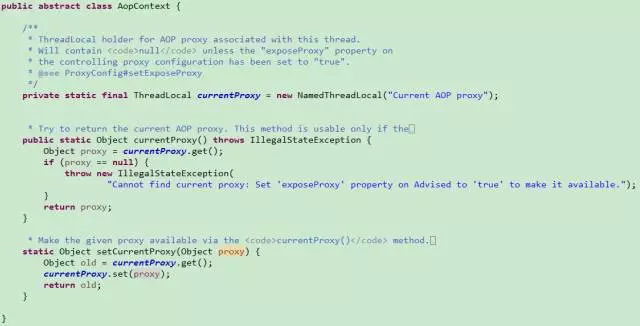使用Spring Aop註解的時候,如@Transactional, @Cacheable等註解一般需要在類方法第一個入口的地方加,不然不會生效。 如下麵幾種場景 1、Controller直接調用Service B方法:Controller > Service A 在Service A 上加@Tra ...

使用Spring Aop註解的時候,如@Transactional, @Cacheable等註解一般需要在類方法第一個入口的地方加,不然不會生效。
如下麵幾種場景
1、Controller直接調用Service B方法:Controller > Service A
在Service A 上加@Transactional的時候可以正常實現AOP功能。
2、Controller調用Service A方法,A再調用B方法:Controller > Service A > Service B
在Service B上加@Transactional的時候不能實現AOP功能,因為在Service A方法中調用Service B方法想當於使用this.B(),this代表的是Service類本身,並不是真實的代理Service對象,所以這種不能實現代理功能。
所以,如果不是直接調用的方式,是不能實現代理功能的,非常需要註意。
但確實有這種不是直接調用的試,也需要實現代理功能,怎麼做呢?很簡單,只需要暴露當前代理對象給當前線程就行了,如下配置,註解粗體的部分。
<!-- aspect -->
<aop:aspectj-autoproxy proxy-target-class="true" **expose-proxy="true"**/>
protected final T proxy() {
return (T) **AopContext.currentProxy()**;
}
這樣就能拿到代理對象了,在Service A中可以通過proxy().B()即可正常實現B方法上面的代理功能。

看下AopContext源碼,Spring會將當前代理對象綁定到當前線程ThreadLocal上面。
關於線程綁定變數參考Java技術棧微信公眾號分享的ThreadLocal文章。
關註公眾號Java技術棧回覆"面試"獲取我整理的2020最全面試題及答案。
推薦去我的博客閱讀更多:
2.Spring MVC、Spring Boot、Spring Cloud 系列教程
3.Maven、Git、Eclipse、Intellij IDEA 系列工具教程
覺得不錯,別忘了點贊+轉發哦!


